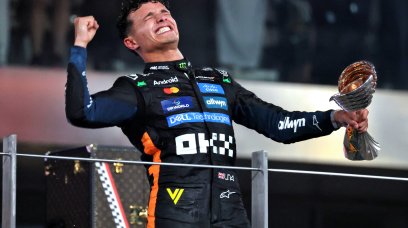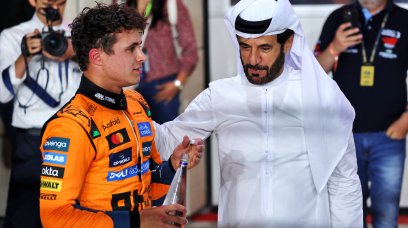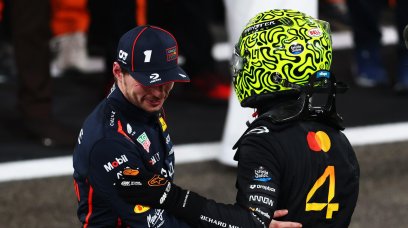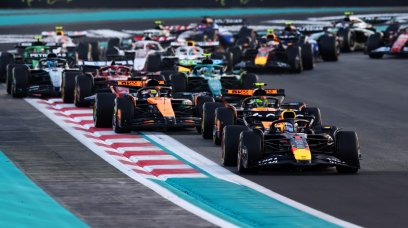Daniel Ricciardo's F1 comeback was confirmed with AlphaTauri to replace Dutchman Nyck de Vries after only 10 races. The decision to oust the former Formula E and F2 champion should come as no surprise given Red Bull and its Motorsport Advisor Helmut Marko's history of culling talent before a season is over. RacingNews365 takes a look back at all the changes made by Red Bull during a campaign.
2005 Red Bull – Christian Klien-Vitantonio Liuzzi
Red Bull's first mid-season driver swap had been established before the campaign had started. It was agreed Christian Klien and Vitantonio Liuzzi [pictured below] would share the second seat alongside former race winner David Coulthard during the team's inaugural season on the grid. Klien drove in the first three events before handing over the reins to Liuzzi for rounds four to seven, but that was to be it for the Italian. After returning for the rest of the season at round nine, Klien managed a total of nine points, compared to Liuzzi's solitary score on debut at Imola.
2006 Red Bull – Christian Klien-Robert Doornbos
Klien's second season with the team didn't go to plan and a string of poor results saw him axed in favour of test driver Robert Doornbos [pictured below] for the final three races in 2006. Despite finishing all three races, Doornbos was unable to secure points and would not take part in an F1 race again. Klien would find his way back to the sport, though only for a short stint with the backmarker HRT team in 2010.
2007 Toro Rosso – Scott Speed-Sebastian Vettel
It became apparent that the junior Toro Rosso team would not be immune to driver changes in 2007, with American Scott Speed kicked out in favour of Sebastian Vettel after a scoreless year and a half with the squad. The fresh-faced German soon got his feet under the table, running as high as third in the wet Japanese Grand Prix before a bizarre collision with Red Bull's Mark Webber behind the Safety Car. Vettel went some way to atoning for that error with a fine fourth place at the next race in China. Vettel quickly established himself as F1's next big thing and took an improbable first win for both himself and Toro Rosso at the 2008 Italian Grand Prix, prompting a promotion to Red Bull for 2009. Thirty-eight wins and four titles later, it's fair to say this was a move that worked out well for Red Bull.
2009 Toro Rosso – Sebastien Bourdais-Jaime Alguersuari
Vettel's departure to Red Bull left Sebastien Bourdais as the de facto team leader at Toro Rosso, but the Frenchman never seemed to recover from having been in the German's wake and was dropped midway through 2009. Bourdai's replacement was Jaime Alguersuari [pictured below], who became F1's youngest debutant at the time, aged just 19 years and 125 days old. The Spaniard did a solid job for Toro Rosso over the next two and a half years, but Red Bull never seemed to have the confidence to promote him to the senior team: Alguersuari was moved aside at the end of 2011 to make way for Daniel Ricciardo and Jean-Eric Vergne. Alguersuari failed to return to an F1 race seat and made the surprising decision to quit all forms of motorsport at just 25 in order to focus on his other career as a DJ.
2016 Red Bull/Toro Rosso – Daniil Kvyat, Max Verstappen
There followed a period of relative calm in the Red Bull waters, with no mid-season driver changes for six years, but a young charger called Max Verstappen soon became impossible to ignore. After a stellar rookie season with Toro Rosso in 2015, Verstappen was promoted to Red Bull to replace Daniil Kvyat four races into 2016, with the Russian going the other way. It took six years for another mid-season change in Red Bull's ranks, but the next was highly significant. Following a drama-filled first four races of the 2016 season, Daniil Kvyat was shifted aside for Max Verstappen at Red Bull - the Dutchman only a year into his F1 career. The decision was vindicated instantly with a win on debut at the Spanish Grand Prix following a collision between both Mercedes drivers on the opening lap. Verstappen would take a handful of wins in the coming years as Red Bull struggled to match Mercedes and Ferrari, but he finally took his first title in 2021 following a ferocious battle with Lewis Hamilton and adding a second a year later.
2017 Toro Rosso – Daniil Kvyat-Pierre Gasly; Carlos Sainz-Brendan Hartley
It was musical chairs at Toro Rosso in 2017, with four different drivers occupying the two seats across the season. Perhaps still smarting from his Red Bull demotion, Kvyat struggled to match the pace of Carlos Sainz in the other car, and the Russian was moved aside mid-season to make way for reigning GP2 champion Pierre Gasly, who had been racing in Japan's Super Formula series. Sainz was on the move just two races later, though this was a promotion of sorts, as the Spaniard was heading to Renault to replace the Jolyon Palmer - who himself had been axed. Stepping into Sainz’s shoes was erstwhile Red Bull junior Brendan Hartley, who had been racing with distinction in the World Endurance Championship. But he found the going tougher in F1, and was dropped at the end of a mediocre 2018 campaign, while Gasly fared somewhat better and earned himself a promotion to Red Bull for 2019…
2019 Red Bull/Toro Rosso – Pierre Gasly-Alex Albon
Unfortunately for Gasly, his dream move quickly turned sour. A crash in pre-season testing seemed to knock his confidence and he never looked close to matching the pace of Verstappen in the sister car. During the summer break, Red Bull once again took the opportunity to go for a mid-season switch and elected to swap Gasly with Toro Rosso's Alex Albon [pictured below], who was having a quietly excellent rookie campaign. However, Albon soon discovered that life is never a bed of roses at Red Bull and he too failed to come close to Verstappen's level. The Thai-British driver survived until the end of 2020 but was then dropped when the form and availability of Sergio Perez - recently let go by soon-to-be Aston Martin - made the Mexican impossible for Red Bull to ignore. By contrast, Gasly thrived back at Toro Rosso [and then AlphaTauri], taking an unlikely but deserved debut win at Monza in 2020 and regularly mixing it with quicker cars. The Frenchman's performances caught the eye of Alpine, who signed him up to replace Fernando Alonso this year. Albon, meanwhile, endured a year out of F1 before returning last season with Williams, with whom he has excelled. A rare redemptive arc for both drivers involved in a Red Bull mid-season switch.
Most read






